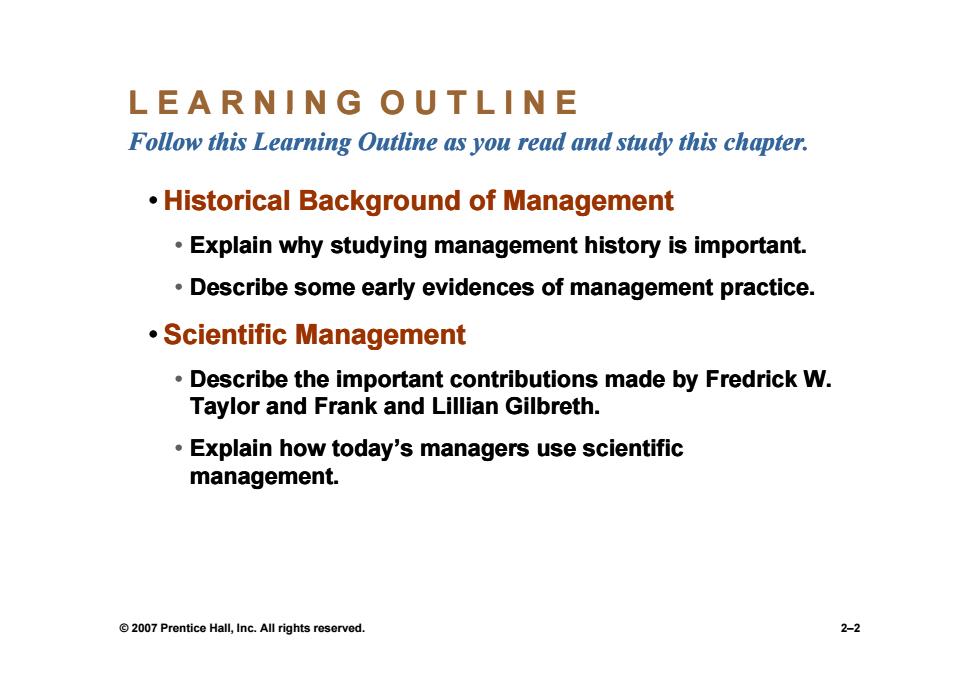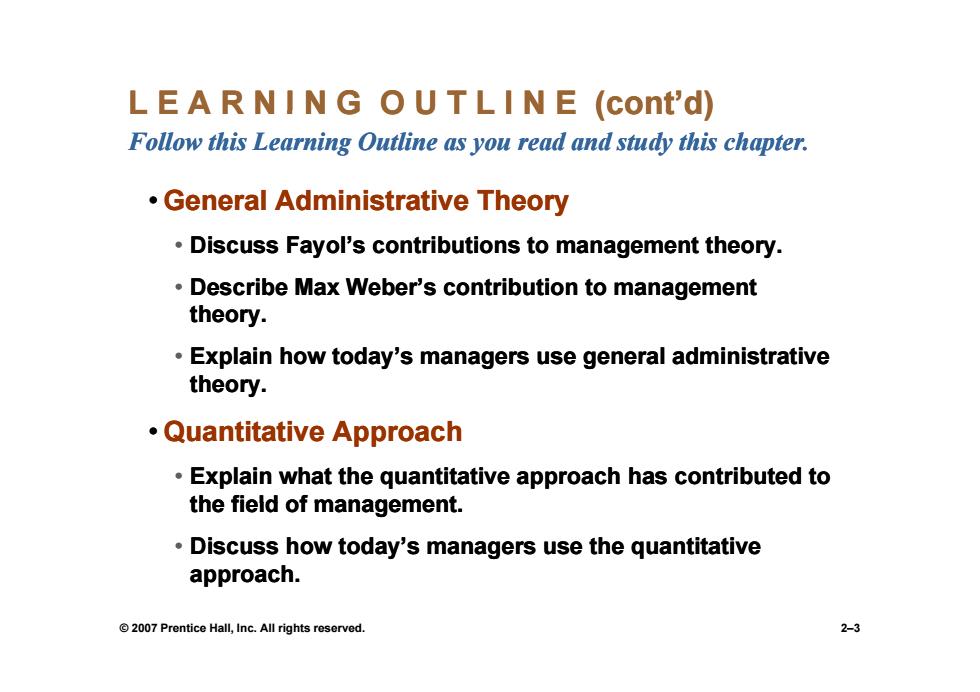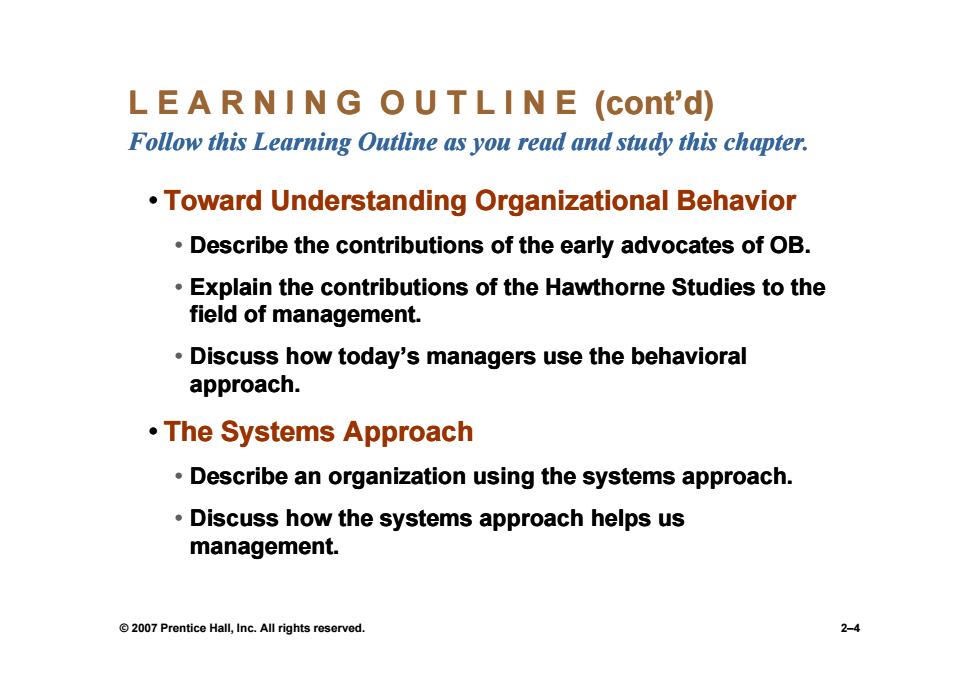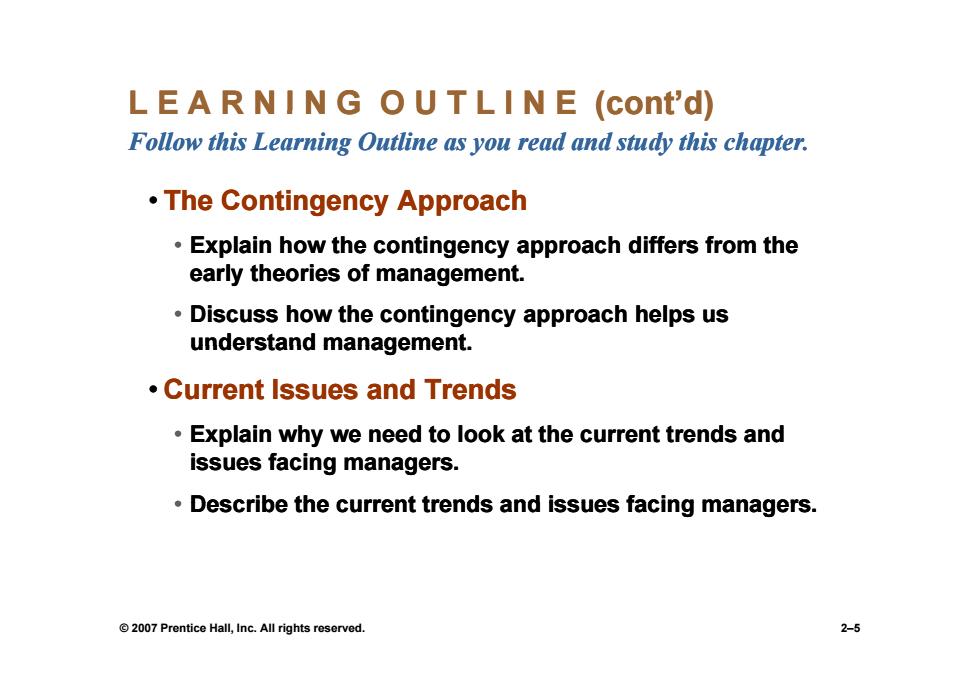
management ninth edition STEPHEN P.ROBBINS MARY COULTER Chapter Management 2 Yesterday and Today PEARSON
ninth edition STEPHEN P. ROBBINS STEPHEN P. ROBBINS MARY COULTER MARY COULTER Management Chapter 2 g Yesterday and Today PowerPoint Presentation by Charlie Cook The University of West Alabama © 2007 Prentice Hall, Inc. All rights reserved

LEARNING OUTLINE Follow this Learning Outline as you read and study this chapter. Historical Background of Management Explain why studying management history is important. Describe some early evidences of management practice. Scientific Management Describe the important contributions made by Fredrick W. Taylor and Frank and Lillian Gilbreth. Explain how today's managers use scientific management. 2007 Prentice Hall,Inc.All rights reserved. 2-2
LEARNING OUTLINE L E A R N I N G O U T L I N E Follow this Learning Outline as you read and study this chapter. • Historical Background of Management • Explain why studying management history is important. • Describe some early evidences of management practice. • Scientific Mana gement • Describe the important contributions made by Fredrick W. Taylor and Frank and Lillian Gilbreth. • Explain how today’s managers use scientific management. © 2007 Prentice Hall, Inc. All rights reserved. 2–2

LEARNING OUTLINE (cont'd) Follow this Learning Outline as you read and study this chapter. General Administrative Theory Discuss Fayol's contributions to management theory. Describe Max Weber's contribution to management theory. Explain how today's managers use general administrative theory. Quantitative Approach Explain what the quantitative approach has contributed to the field of management. Discuss how today's managers use the quantitative approach. 2007 Prentice Hall,Inc.All rights reserved. 2-3
L E A R N I N G O U T L I N E (cont L E A R N I N G O U T L I N E (cont d) (cont d) ’ Follow this Learning Outline as you read and study this chapter. • General Administrative Theory • Discuss Fayol’s contributions to management theory. • Describe Max Weber’s contribution to management theory. • Explain how today’s managers use general administrative theory. • Q tit ti A h Quantit ative Approac h • Explain what the quantitative approach has contributed to the field of management the field of management management. • Discuss how today’s managers use the quantitative approach. © 2007 Prentice Hall, Inc. All rights reserved. 2–3

LEARNING OUTLINE (cont'd) Follow this Learning Outline as you read and study this chapter. Toward Understanding Organizational Behavior Describe the contributions of the early advocates of OB. Explain the contributions of the Hawthorne Studies to the field of management. Discuss how today's managers use the behavioral approach. ·The Systems Approach Describe an organization using the systems approach. Discuss how the systems approach helps us management. 2007 Prentice Hall,Inc.All rights reserved. 2-4
L E A R N I N G O U T L I N E (cont L E A R N I N G O U T L I N E (cont d) (cont d) ’ Follow this Learning Outline as you read and study this chapter. • Toward Understanding Organizational Behavior • Describe the contributions of the early advocates of OB. • Explain the contributions of the Hawthorne Studies to the field of management. • Discuss how today’s managers use the behavioral approach. • Th S t A h The Sys tems Approac h • Describe an organization using the systems approach. • Discuss how the systems approach helps us management. © 2007 Prentice Hall, Inc. All rights reserved. 2–4

LEARNING OUTLINE (cont'd) Follow this Learning Outline as you read and study this chapter. The Contingency Approach Explain how the contingency approach differs from the early theories of management. Discuss how the contingency approach helps us understand management. Current Issues and Trends Explain why we need to look at the current trends and issues facing managers. Describe the current trends and issues facing managers. 2007 Prentice Hall,Inc.All rights reserved. 2-5
L E A R N I N G O U T L I N E (cont L E A R N I N G O U T L I N E (cont d) (cont d) ’ Follow this Learning Outline as you read and study this chapter. • The Contingency Approach • Explain how the contingency approach differs from the earl th i f t ly theories o f managemen managemen t. • Discuss how the contingency approach helps us understand management understand management. • Current Issues and Trends • Explain why we need to look at the current trends and issues facing managers. • Describe the current trends and issues facing managers Describe Describe the current current trends and issues facing managers managers. © 2007 Prentice Hall, Inc. All rights reserved. 2–5